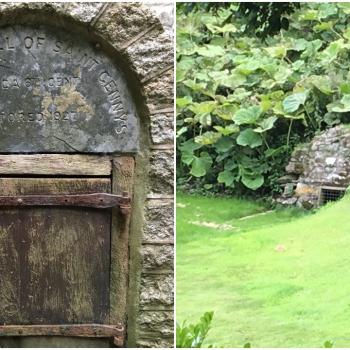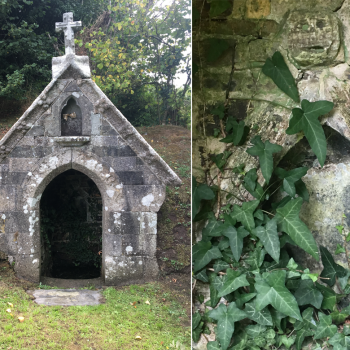English Heritage commissioned a local craftsman to hand-carve the face of Merlin the wizard into the rocks below Tintagel Castle, at the entrance to the inlet known as Merlin’s Cave which according to legend is where Merlin carried the infant King Arthur to safety. The carving, which took three months to complete, was unveiled earlier this month, prompting an outraged statement from the organisation Kernow Matters To Us (KMTU):
“This official vandalism has been condemned by people who love Cornwall, both at home and as far away as Australia. We are deeply shocked that the inappropriately named ‘English’ Heritage has installed a sculpture of Merlin in our Cornish Tintagel Castle. This is nothing but ‘false’ history and diminishes our heritage. It is a disgrace. No doubt it will enhance tourist numbers for a season or two – but at the cost of further denuding the Cornish cultural and historical context of this location.”
– “English Heritage accused of ‘vandalism’ after Merlin sculpture at Tintagel Castle causes outrage,” The Telegraph, February 16th 2016
![Jane Osborne [CC BY-SA 2.0 (http://creativecommons.org/licenses/by-sa/2.0)], via Wikimedia Commons](https://wp-media.patheos.com/blogs/sites/632/2016/02/MerlinsCave-300x205.jpg)
What’s more, the Merlin carving is pretty subtle. It’s quite small and flows very naturally from the rocks – at a quick glance it could even be mistaken for a natural formation. As Alex Page of English Heritage states,
“Our new carving reflects the legendary link between Tintagel Castle and Merlin. We took great care to ensure that the carving complements rather than competes with the spectacular setting. The carving of Merlin’s face is discreet, a little larger than life, and is tucked away amongst the rocks for people to discover.”
– “English Heritage accused of ‘vandalism’ after Merlin sculpture at Tintagel Castle causes outrage,” The Telegraph, February 16th 2016
Considering Tintagel’s history of locals carving mystical symbols into rocks as demonstrated by the Rocky Valley labyrinths, you could perhaps say that the Merlin carving is a continuation of intangible cultural heritage – in other words, traditions and practises that continue from generation to generation. Tradition is not something that exists in the past – it is something that we do in the here and now, following the examples of those before us. That’s why I believe that the Merlin sculpture in fact enhances, rather than diminishes, the cultural traditions of Cornwall, both by reminding us of the Celtic legends that enrich Tintagel’s heritage, and by continuing its curious culture of creating beautiful, magical works of art using the natural surroundings.
Sources:
“The Rocky Valley Labyrinths,” Abegael Saward. Labyrinthos.
“English Heritage accused of ‘vandalism’ after Merlin sculpture at Tintagel Castle causes outrage,” The Telegraph, February 16th 2016












